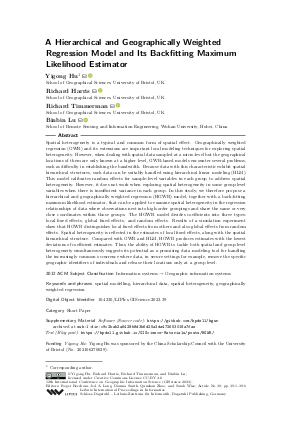A Hierarchical and Geographically Weighted Regression Model and Its Backfitting Maximum Likelihood Estimator (Short Paper)
Authors
Yigong Hu  ,
Richard Harris
,
Richard Harris  ,
Richard Timmerman
,
Richard Timmerman  ,
Binbin Lu
,
Binbin Lu 
-
Part of:
Volume:
12th International Conference on Geographic Information Science (GIScience 2023)
Part of: Series: Leibniz International Proceedings in Informatics (LIPIcs)
Part of: Conference: International Conference on Geographic Information Science (GIScience) - License:
 Creative Commons Attribution 4.0 International license
Creative Commons Attribution 4.0 International license
- Publication Date: 2023-09-07
File

PDF
LIPIcs.GIScience.2023.39.pdf
- Filesize: 0.73 MB
- 6 pages
Document Identifiers
Subject Classification
ACM Subject Classification
- Information systems → Geographic information systems
Keywords
- spatial modelling
- hierarchical data
- spatial heterogeneity
- geographically weighted regression
Metrics
- Access Statistics
-
Total Accesses (updated on a weekly basis)
0PDF Downloads0Metadata Views
Abstract
Spatial heterogeneity is a typical and common form of spatial effect. Geographically weighted regression (GWR) and its extensions are important local modeling techniques for exploring spatial heterogeneity. However, when dealing with spatial data sampled at a micro-level but the geographical locations of them are only known at a higher level, GWR-based models encounter several problems, such as difficulty in establishing the bandwidth. Because data with this characteristic exhibit spatial hierarchical structures, such data can be suitably handled using hierarchical linear modeling (HLM). This model calibrates random effects for sample-level variables in each group to address spatial heterogeneity. However, it does not work when exploring spatial heterogeneity in some group-level variables when there is insufficient variance in each group. In this study, we therefore propose a hierarchical and geographically weighted regression (HGWR) model, together with a back-fitting maximum likelihood estimator, that can be applied to examine spatial heterogeneity in the regression relationships of data where observations nest into high-order groupings and share the same or very close coordinates within those groups. The HGWR model divides coefficients into three types: local fixed effects, global fixed effects, and random effects. Results of a simulation experiment show that HGWR distinguishes local fixed effects from others and also global effects from random effects. Spatial heterogeneity is reflected in the estimates of local fixed effects, along with the spatial hierarchical structure. Compared with GWR and HLM, HGWR produces estimates with the lowest deviations of coefficient estimates. Thus, the ability of HGWR to tackle both spatial and group-level heterogeneity simultaneously suggests its potential as a promising data modeling tool for handling the increasingly common occurrence where data, in secure settings for example, remove the specific geographic identifiers of individuals and release their locations only at a group level.
Cite As Get BibTex
Yigong Hu, Richard Harris, Richard Timmerman, and Binbin Lu. A Hierarchical and Geographically Weighted Regression Model and Its Backfitting Maximum Likelihood Estimator (Short Paper). In 12th International Conference on Geographic Information Science (GIScience 2023). Leibniz International Proceedings in Informatics (LIPIcs), Volume 277, pp. 39:1-39:6, Schloss Dagstuhl – Leibniz-Zentrum für Informatik (2023)
https://doi.org/10.4230/LIPIcs.GIScience.2023.39
BibTex
@InProceedings{hu_et_al:LIPIcs.GIScience.2023.39,
author = {Hu, Yigong and Harris, Richard and Timmerman, Richard and Lu, Binbin},
title = {{A Hierarchical and Geographically Weighted Regression Model and Its Backfitting Maximum Likelihood Estimator}},
booktitle = {12th International Conference on Geographic Information Science (GIScience 2023)},
pages = {39:1--39:6},
series = {Leibniz International Proceedings in Informatics (LIPIcs)},
ISBN = {978-3-95977-288-4},
ISSN = {1868-8969},
year = {2023},
volume = {277},
editor = {Beecham, Roger and Long, Jed A. and Smith, Dianna and Zhao, Qunshan and Wise, Sarah},
publisher = {Schloss Dagstuhl -- Leibniz-Zentrum f{\"u}r Informatik},
address = {Dagstuhl, Germany},
URL = {https://drops.dagstuhl.de/entities/document/10.4230/LIPIcs.GIScience.2023.39},
URN = {urn:nbn:de:0030-drops-189342},
doi = {10.4230/LIPIcs.GIScience.2023.39},
annote = {Keywords: spatial modelling, hierarchical data, spatial heterogeneity, geographically weighted regression}
}
Author Details
Funding
- Hu, Yigong: Yigong Hu was sponsored by the China Scholarship Council with the University of Bristol (No. 202106270029).
Supplementary Materials
-
Software (Source code)
https://github.com/hpdell/hgwr
browse
 archived version
archived version
- Text (Blog post) https://hpdell.github.io/GIScience-Materials/posts/HGWR/
References
- Naomi E. Allen, Cathie Sudlow, Tim Peakman, and Rory Collins. Uk biobank data: Come and get it. Science Translational Medicine, 6(224):1-4, February 2014. URL: https://doi.org/10.1126/scitranslmed.3008601.
-
Luc Anselin. Spatial Econometrics: Methods and Models. Number 4 in Studies in operational regional science. Kluwer Academic Publishers, Dordrecht, Boston, 1988.

- Chris Brunsdon, A. Stewart Fotheringham, and Martin E. Charlton. Geographically weighted regression: A method for exploring spatial nonstationarity. Geographical Analysis, 28(4):281-298, February 1996. URL: https://doi.org/10.1111/j.1538-4632.1996.tb00936.x.
- Feng Chen, Yee Leung, Chang-Lin Mei, and Tung Fung. Backfitting estimation for geographically weighted regression models with spatial autocorrelation in the response. Geographical Analysis, 54(2):357-381, April 2022. URL: https://doi.org/10.1111/gean.12289.
- A. Stewart Fotheringham and Chris Brunsdon. Local forms of spatial analysis. Geographical Analysis, 31(4):340-358, September 2010. URL: https://doi.org/10.1111/j.1538-4632.1999.tb00989.x.
- A. Stewart Fotheringham, Wenbai Yang, and Wei Kang. Multiscale geographically weighted regression (mgwr). Annals of the American Association of Geographers, 107(6):1247-1265, November 2017. URL: https://doi.org/10.1080/24694452.2017.1352480.
-
Dorothy Margaret Greig. Optimisation. Longman Publishing Group, 1980.

- A. M. Latimer, S. Banerjee, H. Sang Jr, E. S. Mosher, and J. A. Silander Jr. Hierarchical models facilitate spatial analysis of large data sets: a case study on invasive plant species in the northeastern united states. Ecology Letters, 12(2):144-154, February 2009. URL: https://doi.org/10.1111/j.1461-0248.2008.01270.x.
- Binbin Lu, Chris Brunsdon, Martin Charlton, and Paul Harris. Geographically weighted regression with parameter-specific distance metrics. International Journal of Geographical Information Science, 31(5):982-998, May 2017. URL: https://doi.org/10.1080/13658816.2016.1263731.
-
Stephen W. Raudenbush. Hierarchical linear models and experimental design. In Applied Analysis of Variance in Behavioral Science, pages 459-496. L. K. Edwards, 1993.

